Bounded Confidence and Cohesion-Moderated Pressure: A General Model for the Large-Scale Dynamics of Ordered Opinion
Abstract
1. Introduction
1.1. Opinion Evolution: Micro-Mechanisms and Macroscopic Issues
1.2. General Model: Bounded Confidence and Its Properties
1.2.1. Modeling
1.2.2. Synchronization Research
1.2.3. Data Validation: Random Optimization and Bayesian Approaches
1.3. Literature Summary and Subsequent Research
2. Model and Theorems
2.1. Overview
2.2. Model
- (1)
- Environment: The environment of our model includes a social network , a confidence threshold set , a social learning/exclusion rate set , and a pressure coefficient set . Here, in G represents the set of all individuals/the set of all relationships between individuals (individuals can be called agents in the following text). Specifically, vi represents individual i (abbreviated as i), and eij represents the social relationship between individual i and individual j. di in D represents the confidence threshold of vi depending on the agent i, whose meaning is the same as the confidence threshold in the D-W model. uij in U represents the “social learning rate of vi towards vj’s opinion”/“the social influence rate of vj on vi’s opinion”, that is, “the degree to which vi adopts vj’s opinion after interacting with each other”. ki in K represents the influence of group pressure/mainstream opinion on individual i, hence the term “pressure coefficient”.
- (2)
- Variables: The variables of our model encompass opinion xi(t), social neighborhood N(i), and confidence neighborhood N(i, t), which can be explained respectively. First, Each individual vi has an opinion value at time t, denoted as , representing preferences for certain goods or political positions on certain events, etc. Second, each individual vi has a “social neighborhood”, denoted as , which represents all individuals in the social network G who have relationships with vi, such as being friends or following each other. Third, each individual vi has a “confidence neighborhood” denoted as , which represents all individuals vj whose opinion difference with vi at time t is not greater than the larger of i’s and j’s thresholds. Under the bounded confidence hypothesis, this represents “all agents with whom vi could potentially engage in communication at least unilaterally” (regardless of whether “vi initiates communication with vj” or “vj initiates communication with vi”; this is because it just needs a single person to start a conversation in most scenes).
- (3)
- In-group Rule: At time t, for any individual vi, considering all individuals vj in Ni∩Nit (i.e., individuals with whom vi has a social relationship and whose opinion differences can be trusted and accepted by vi), a subset is randomly selected from this set to interact and exchange opinions with i, and the selection is denoted as a random event wt, with its probability defined in some contents like M1/M2/M3 in the section of Main Theorems and Appendix A. (This is because strictly defining probability is very cumbersome and relies on the measure theory, so it is included in the Appendix A). This subset consists of all individuals who interact with i, written as N(i, t). In this context, we denote the average influence of all vj’s opinions on vi as , where uij ∈ U represents the social learning rate defined earlier, and |·| represents the cardinality of a set. Additionally, individual i retains a portion of his original opinion, denoted as , where the coefficient of xi(t) is for weight normalization purposes.
- (4)
- Out-group Rule: At the same time, at time t, individual i browses information posted by other individuals in the social network G and is influenced by the average opinion of the network. The degree of this influence is adjusted by the “difference between individual i’s opinion and the mean opinion in Ni(t)” (referred to as “local discrepancy”), denoted as . Then, We can denote the environmental noise experienced by individual i at time t as the following equation: , representing the adjusted group pressure. The overall effect of this pressure on individual i’s opinion is related to the pressure coefficient and denoted as .
- (5)
- The General Equation: Based on the rules described in (3) and (4), after opinion exchange/random event wt occurs, the opinions of all individuals i evolve from xi(t) to xi (t + 1), following the update equation:
2.3. Main Theorems
3. Results: Experiment Design and Simulation Analysis
3.1. Overview
3.2. Simulation Experiment Design
- (1)
- Arising from the mechanisms of imitation and exclusion, assign the variable “u” into two categories (denoted as u > 0/u < 0).
- (2)
- Under these two categories of u, analyze the impact of parameter “d” on the evolutionary outcomes of opinions separately. When u > 0, the experimental procedure entails the following steps: A. Control the values of u, d*, and k and observe the simulation results at various values of “d”; B. Conduct multiple experiments using fixed parameter values of d, u, d*, and k; C. Visualize the simulation results, such as the trend of individual opinion values, frequency of global synchronization, and distribution of consensus numbers; Similarly, when u < 0, perform simulation experiments analogous to those conducted when u > 0, such as controlling the same values of d*.
- (3)
- Finally, summarize and compare the obtained results to elucidate the comprehensive influence of “d” on the evolution of opinions under different values of “u”.
- (1)
- Set up the imitators/repulsors proportion, denoted as α/1 − α.
- (2)
- Employing the simulation strategy of the homogeneous model, control a set of d/d*/k values that lead to synchronization (when ui > 0) and simulate varying α values to comprehend their impact on consensus formation. Subsequently, we can depict relevant charts based on the results.
3.3. Simulation Results Analysis
3.3.1. Global Consensus
3.3.2. Local Consensus
3.3.3. Chaos Phenomenon
4. Discussions: Ideal Synchronization Theory
4.1. Overview
4.2. Main Part
- (1)
- Regarding the first aspect, when the value of k is small, even if the noise (i, j, t) is substantial (indicating pronounced out-group pressure/low in-group cohesion), the pressure perceived by individual i, denoted as k*noi(i, j, t), remains insufficient to align his opinion with the global average opinion. Therefore, in the early stages of opinion evolution, under the limitations of low reachability (truncation), individuals are unable to communicate with a sufficient number of people, and due to the low-pressure coefficient k, they cannot fully adopt the majority opinion or the average opinion in the network. This results in a large number of individuals only assimilating with people within their social neighborhood or people who are similar to their own opinions (d/d * limitation) for a long time, causing multiple local consensuses within the system.
- (2)
- As for the second aspect, due to the regulation of cohesion (approaching | xi xj | ≈ 0), group pressure perceived by people is too small to foster consensus formation, thus upholding the prevailing local consensus. This is consistent with the principle of the first aspect, which states that individuals do not consider the average opinion (representing the majority) when there are few people communicating, but the reason for it is that due to the enhanced in-group cohesion, individuals fall into group blindness and no longer accept people from the out-group.
- (3)
- These two aspects can be termed the “cocoon room mechanism”, encapsulating the shielding effect of external information and the external group influence. In conclusion, the answer to questions 2-2 includes the “truncation” caused by low reachability and the “cocoon room mechanism” (high cocoon room effect means low homogenization represented by pressure coefficient k). This answer will be noted as A2* below.
4.3. Supplementary Conclusions
5. Validation: Verifying the Theory with Real Data
5.1. Overview
5.2. Data Description
5.3. Inference Methods
5.3.1. Validation and Estimation
5.3.2. Fitting and Testing
5.4. Results and Analysis
5.4.1. Parameter Estimation and Fitting
5.4.2. Distribution Test
6. Conclusions and Prospects
6.1. Conclusions
6.2. Prospect
Author Contributions
Funding
Institutional Review Board Statement
Data Availability Statement
Conflicts of Interest
Appendix A. Strict Definitions and Theorems
Appendix A.1. Axiomatic Framework
Appendix A.2. Notations
Appendix A.3. Definitions
- ①
- The original rule
- ②
- The alternative ruleGiven graph G, let . It is easy to verify that is a stochastic dynamic, namely the ‘opinion dynamic’.
- (1)
- Let the opinion space X be a bounded set [0, 1]n. The image set of the rule F is also [0, 1]n, in order to meet the measurement requirements of ordered perspectives (most datasets map them to real values within 0–1). The mathematical definition of noi(i, j, t + 1) can be found in the following text.
- (2)
- The framework includes three important parameters: d represents the confidence threshold, and i and j can interact only if the difference in their opinions is below the threshold; uij represents the social learning rate of i from j, that is, the influence of j’s opinion on i’s opinion; and ki represents the compression coefficient of i, indicating the degree to which individual i perceives group pressure. There is also an important variable: N(i, t, x0, w) represents “all individuals j interacting with individual i at time t given the initial opinions x0 and the sequence of interaction events w”.
- (3)
- The fundamental meaning of the above framework is that at any given time t, there exist two categories of individuals: non-participants (referred to as NP) and participants (referred to as P). The criterion for determining whether an individual j belongs to NP or P is based on whether there exists an i in the random event wk who interacts with j, that is, whether the value of Interij(wk) is zero. Based on this criterion, the opinions of individuals in NP remain unchanged, while the opinions of individuals in P are influenced by three levels: (1) their existing perspective xi, (2) the weighted average of the opinions xj of all individuals interacting with them, and (3) the average opinion of the system (noise/group pressure). Among them, the parameter uij reflects the social influence effect, and the parameter di represents the influence of bounded confidence.
- (4)
- The difference between the alternative rule and the original rule lies in the fact that when the difference in opinions between individuals i and j is greater than d, under the original rule, the probability of an interaction between i and j is 0, while under the alternative rule, i and j will not interact.
- ①
- The original rule, it can be represented as
- ②
- The alternative rulewhich is the same as the original rule.
- ①
- and ;
- ②
- ;
- ③
- ;
- ④
- , ;
- ⑤
- ①’
- same with ;
- ②’
- ;
- ③’
- ;
- ④’
- , ;
- ⑤’
- .
- ①”
- is a connected graph;
- ②”
- i, di d = 1;
- ③”
- (1)
- M1 implies that there exists an agent vi in the system who frequently interacts with any other agent, and these individuals are influenced by external group pressure and internal cohesion during interactions.
- (2)
- M2 implies that the system is entirely determined by the “bounded confidence mechanism”, and agents are not influenced by the external group during interactions. This is a generalization of many existing bounded confidence models (including the D-W model).
- (3)
- M3 implies that the system’s rules, once fixed, can combine social influence with the French-Degroot model.
- ε
- is a generalized fixed point of F a.s.
- ε
- is a stochastic fixed point of F is a generalized fixed point of F, and is measurable.
- ε
- is a stochastic global attractor of , , and given , .
- ε
- is a stable stochastic fixed point of is a stochastic fixed point of , and { , , if , , } = 1.
- (1)
- “The stochastic fixed point x0” implies that “after random occurrences of any opinion interaction wt, the viewpoint state x0 remains unchanged, i.e., F(wt)x0 = x0”.
- (2)
- “The stochastic global attractor x0” implies that “x0 is a stochastic fixed point, and for any opinion state x*, after undergoing numerous evolutions according to almost any opinion rule F(wt), it will approach/be attracted to the vicinity of state x0”.
- (3)
- “The stochastic stable fixed point x0” implies that “x0 is a stochastic fixed point, and for opinion states x* around x0 at time t, even after infinite evolutions according to the opinion rule F(wt), they will still be in the vicinity of x0”.
- ①
- ②
- ③
- ④
- ①
- is convergent and , it can be verified as an equivalent relationship;
- ②
- ;
- ③
- ;
- ④
- and , , , ,
Appendix A.4. Main Theorems
- (1)
- The theorem provides a significant conclusion to address Question 1. Referring to the definition of M1, it can be inferred that the magnitudes of the social learning rate (u) and group pressure (k) are almost unrelated to global synchronization. However, the sequence of network degrees and the threshold of confidence have a considerable impact on it. Furthermore, Theorem 1 explains a phenomenon known as the “active agent effect”, wherein “in a system of opinions, if there exist active agents capable of interacting with any other individual, and there is an assimilation effect among individuals, then the system can evolve towards global consensus”. This inference from the theorem can also serve as a synchronicity conclusion for models such as Deffuant et al.
- (2)
- The proof strategy for the theorem can be illustrated as shown in the following figure, known as the “energy decrease method” (by stochastic functional analysis and differential dynamical systems theory). It implies that the synchronicity of the model (as seen in the upper-left diagram) can be understood as a specific type of dynamical system attractor (as seen in the upper-right diagram). In other words, asynchronous system states will evolve towards synchronous states under rule F. As depicted in the upper-right diagram, the opinion values of x1 and x2 gradually converge around x1 = x2. Based on this, the specific approach involves constructing an energy function V that represents the degree of deviation of the system state relative to the synchronization point. It is then demonstrated that the infimum of V remains nearly constant and is unaffected by w (as seen in the lower-left diagram), leading to the inclusion of the system’s positive limit set within the points x0 that keep V invariant (the points where V equals 0). It is further explained that x0 possesses global attractiveness and stability, thus resulting in synchronicity.
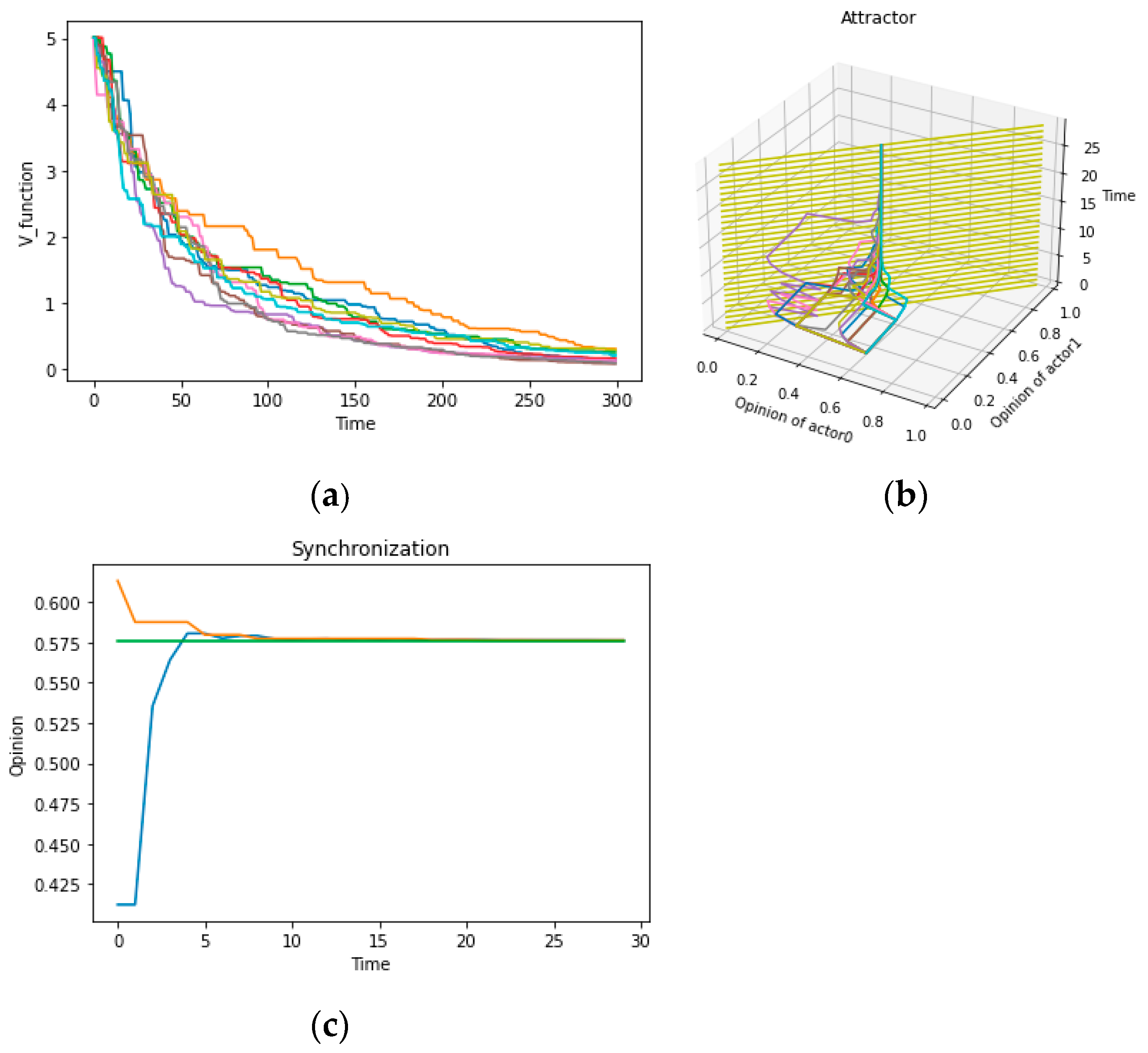
- (1)
- The theorem provides a direction to address Question 2. It provides an upper bound on the number of consensuses when a confidence threshold is determined and illustrates that the threshold’s magnitude is inversely related to the quantity of consensus. The sociological interpretation states that “when the individual tolerance level is high, the system exhibits fewer types of consensus” (i.e., “local consistency in opinion formation”).
- (2)
- The proof strategy for the theorem also needs to be referred to in the following figure, named the “cross-d search” method. The approach can be explained by considering the following figure: A. Proving the convergence of the opinion state x(t) requires first determining the minimum value min1(t) and then proving that “for all xj(t) that differ from min1(t) by less than d, they can converge to a small neighborhood B = B(min1(t), δ) of min1(t)”. It is further demonstrated that “there exists a moment T at which a minimum value min2(t) outside of B, with a distance greater than d from B, exists”. Finally, it is shown that min2(t) satisfies the same relation with min3(t)…mini(t) satisfies with mini + 1(t), thus deducing that the opinions x(t) can converge to (x1…xn) for any w; B. The upper bound on the number of consensuses is derived by utilizing the convergence of the opinion states and the probability conditions of interactions among individuals.
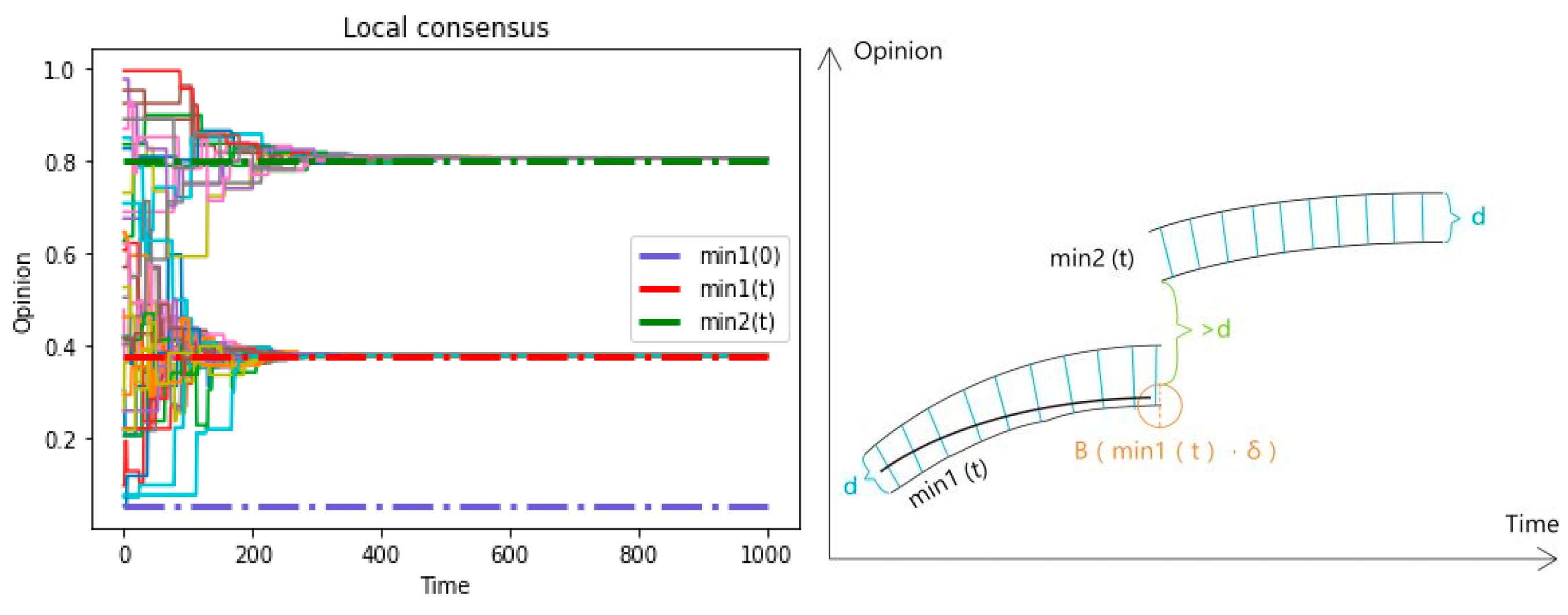
- (1)
- Theorem 3 addresses Question 3 under the condition of an autonomous system. Its sociological interpretation states that “when there is a certain level of social exclusion among individuals and interactions between actors continue, the opinion system will exhibit chaotic phenomena”.
- (2)
- The intuitive representation of chaotic phenomena can be observed in the below diagram.
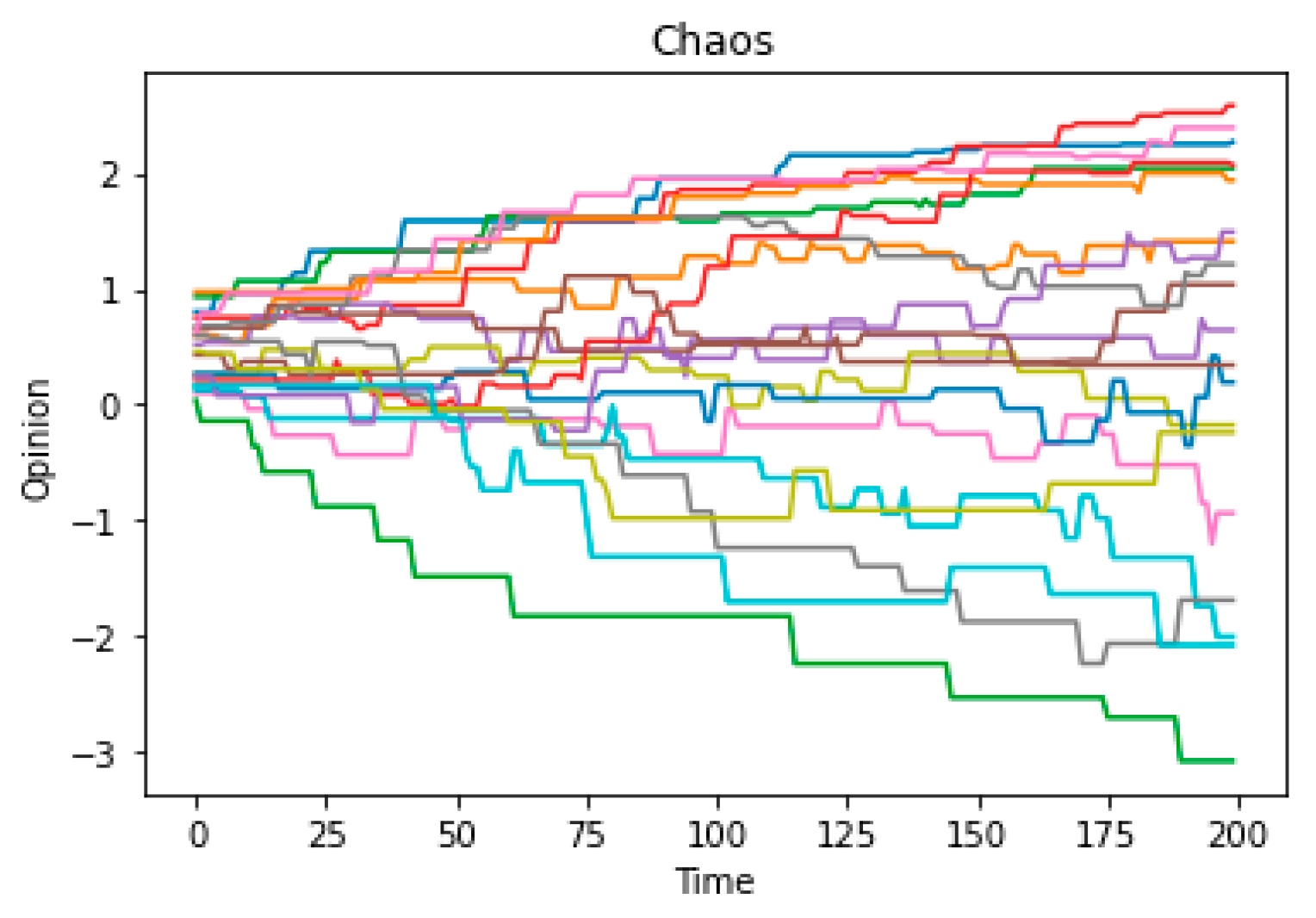
Appendix B. The Proof of Theorems
Appendix B.1. The Proof of Theorem 1
- I.
- For every and , let . According to the intermediate value theorem, we know that , when , holds.
- II.
- implies that , thus .
- (1)
- , .
- (2)
- is a positive definite function and is bounded.
- (3)
- .
- ①
- Since is a compact sequence, and is bounded, then must have a convergent subsequence, written as , thus .
- ②
- , because has a lower bound and it is non-increasing, then (c is related to w). Furthermore, from the continuity of , we know that (this is because is a subsequence of , and the limit of a subsequence is equal to the limit of the sequence). , since we obtain the conclusion that
- ③
- (1)
- When we have measurability clearly holds true.
- (2)
- If the conclusion holds true when , we know that
- ①
- Given , define , thus:When , in the formula represents function composite and matrix multiplication. To illustrate the measurability of when , we need to verify the measurability of , relative to and . Because is continuous (projective mapping), it is also measurable, so we will verify the measurability of .
- ②
- For , given , if can be represented by a matrix below:
- ①
- when ,
- ②
- if the conclusion holds when , then when , thus we have , so it also holds.
- ①
- and
- ②
- and
- (1)
- Generalized fixed point
- (2)
- Measurability
- ①
- if , then
- ②
- if , thenNamely,□
- (1)
- If , , then
- (2)
- If , from Lemma A5, we know
- (1)
- if
- (2)
- if ,
- (1)
- , obviously, is the lower bound of V(t), thus
- (2)
- If , namely , then , , , we have and , . From the non-descending feature of , we know , . Given the enough large, given enough small, when , , there are two conditions:
- ①
- Let , , , we can, respectively, discuss by A and B below.A. To consider , which is because: for satisfying , if is not in synchronization state, will be not in synchronization state, and , , and , so , namely, .Therefore,Thus, we can take appropriate and , which can satisfy the below conclusion:B. To consider , further define the set that is not in synchronization state .B1. Obviously, .B2.Therefore, from A and B, we know that
- ②
- For , namely, for , , which is similar to A in ①, then .To synthesize ①②, , which is a contradiction, thus .
- ①
- From Lemmas A6 and A7, the translation system has a stable stochastic fixed point and stochastic global attractor . Therefore, , , so is a stable stochastic fixed point and stochastic global attractor of .
- ②
- From Lemma A8, we know that stochastic global attraction can lead to a quasi-consensus. Further, based on the stability of , has a stable quasi-consensus. □
Appendix B.2. The Proof of Theorem 2
- I.
- Given arbitrarily, Let be a permutation of V(t), which sorts i in V(t) from small to large by the value of , and can be denoted as . Given , we obtain: , , for i that interacts with the other agent at the time t; the equation reflecting its dynamics can be briefly written as . Thus, we know and , so the inequality holds below:, written as in the following part.
- II.
- Given the set A same as above, , we consider and know:
- (1)
- When and let, we obtain , and is non-decreasing/non-increasing, then and we know that
- (2)
- , namely and suppose only one k that satisfies this condition (which can be generalized to n), from the non-existence of , we know: there is a partitioning of , namely and , which can satisfy and . Thus, , and , we have
- ①
- (fixed agents) ;
- ②
- (Activable agents) from , we know and holds, and , so . Therefore, , namely .
- xi(t) Under (or above E*(t)) will be convergent., we have .From Lemma A9, we deduce that and .Thus, and , so and . Then, it is known by induction that . Therefore, and , or , . Namely, , and we can obtain the equation:
- xi(t) in E*(t) will be convergent , given arbitrarily.
- (1)
- If , then , , so keep the feature, . By induction, we know , thus holds, and
- (2)
- if , given , let (also equal to ). From Lemma A9 and ( is the set given in Lemma A9), we know is bounded and non-decreasing, thus , .
- ①
- To consider the limit of , written as ,By the convergence of min1(t), , , . From , we know .I. Suppose and , (written as ), and .For the condition that “ and ”, we know: given , given , firstly, there is a satisfying the condition; then let , there is a satisfying the condition… Based on this procedure, for w in A, there are countable satisfying the condition.II. Based on the conclusion of I, let , which is obviously not equal to . Given the apagogical hypothesis is , we know the below conclusion:and .For the proof of the first equal sign, we take and fix the , given , if , will not change; if , , will increase more than l (from Lemma A9). For the proof of the second inequality, from I, the cardinality of is same with and , thus , and , the inequality holds. From this, and , which is a contradiction. Therefore, and . Furthermore, Let ,III, From II, the probability of “, , ” is equal to 1. Furthermore, given , we define , and use the apagogical arguments. For w in measure in II, , , we take , and find based on II satisfying , then we take and consider the apagogical arguments hypothesis, knowing some points below:A.B. Given , if , . Thus, , which is a contradiction, so does not exist, or , and then we obtain .
- ②
- To consider .When , we define like min2(t) in ①, and view as as . After discussing like above process, we know: , , then . Furthermore, we have , which satisfiesand . Because , (just finite numbers of i, which written as m) . After ordering, we prove that .In conclusion, when x(0) belongs to [0, 1]n and w belongs to A, we have . □
Appendix B.3. The Proof of Theorem 3
- ①
- For ([0, 1]n, Ω, ) has chaos, , we obtain that , , , so does not exist.
- ②
- Suppose ([0, 1]n, Ω, ) has quasi-consensus, and it also has L-Y chaos, when , Let , From the continuity of the norm, we know that exists, which is contradicted with ①, so the hypothesis does not hold.Therefore, if ([0, 1]n, Ω, ) has chaos, it will not have quasi-consensus. □
- I.
- (1) compact set , andLet , , , thus are the fixed points of . Then we can take a obviously enough small , making and , compact (bounded closed set).
- ①
- Let , because is a homeomorphism, . After induction, we know that , . Therefore, given arbitrarily (namely is on the sphere). Similarly, after induction, we can obtain .Let , , then , namely, the distance between the boundary of and is more than . Meanwhile, because the homeomorphism keeps the simply connected feature (homeomorphism homotopy same Fundamental group simply connected), is still a closed manifold, and all points inside still belong to , thus and , namely, . Therefore, the first conclusion is proved.
- ②
- Same with ①, we can find , wherein , so ,
To synthesize ①②, let , then . - II.
- , can ‘shrink to less than or equal to a point’.
- ①
- is compact and is continuous.For , because and is a closed set (under the metric topology), can be a metric subspace of based on the sub-topology/sub-metric. Thus, is compact;For , we know is the component of linear mapping, and is obviously continuous. is also continuous, so is continuous. Therefore is continuous.
- ②
- , then is expansive and .From Lemma A12, if is expanding, then is expansive. Then, from Lemma A14, we know
- ③
- has chaos and does not have quasi-consensus.From and the theorem in [52], has chaos. Then, from Lemma A13, it does not have quasi-consensus.In conclusion, from Lemma A11, we know P{([0, 1]n, Ω, ) has chaos} = 1, and ([0, 1]n, Ω, ) does not have quasi-consensus. □
Appendix C. The Methods for Estimation and Test
Appendix C.1. The Method for Estimation
Appendix C.2. The Algorithm for Testing
- Step1
- Obtain the sampling frame of by simulation, namely
- Step2
- Obtain the sampling frame of and , namely ,
- Step3
- Obtain samples from the sampling frame of , = 50.
- Step4
- Test and , if they all holds, . Thus, .
Appendix C.3. Equivalence of Rules(F/T) and Distributions(x^(t)/x(t))
References
- Noorazar, H. Recent Advances in Opinion Propagation Dynamics: A 2020 Survey. Eur. Phys. J. Plus 2020, 135, 20. [Google Scholar] [CrossRef]
- Friedkin, N.E. Social Influence Network Theory: A Sociological Examination of Small Group Dynamics; Cambridge University Press: Cambridge, UK, 2011. [Google Scholar]
- Friedkin, N.E. Theoretical Foundations for Centrality Measures. Am. J. Sociol. 1991, 96, 1478–1504. [Google Scholar] [CrossRef]
- Melamed, D.; Savage, S.V. Status, Faction Sizes, and Social Influence: Testing the Theoretical Mechanism. Am. J. Sociol. 2016, 122, 201–232. [Google Scholar] [CrossRef] [PubMed]
- Peng, L.Ü. Life Cycle Model of Online Group Behavior. J. Soc. Sci. Hunan Norm. Univ. 2021, 50, 1–14. [Google Scholar]
- Hegselmann, R.; Krause, U. Truth and Cognitive Division of Labour First Steps towards a Computer Aided Social Epistemology. JASSS-J. Artif. Soc. Soc. Simul. 2006, 9, 28. [Google Scholar]
- Acemoglu, D.; Ozdaglar, A. Opinion Dynamics and Learning in Social Networks. Dyn. Games Appl. 2011, 1, 3–49. [Google Scholar] [CrossRef]
- Stauffer, D.; Meyer-Ortmanns, H. Simulation of Consensus Model of Deftuant Et Al. On a Barabasi-Albert Network. Int. J. Mod. Phys. C 2004, 15, 241–246. [Google Scholar] [CrossRef]
- Bruns, A. Echo Chamber? What Echo Chamber? Reviewing the Evidence. In Proceedings of the 6th Biennial Future of Journalism Conference, Cardiff, UK, 14–15 September 2017. [Google Scholar]
- Terren, L.; Borge-Bravo, R. Echo Chambers on Social Media: A Systematic Review of the Literature. Rev. Commun. Res. 2021, 9, 99–118. [Google Scholar] [CrossRef]
- Das, A.; Gollapudi, S.; Munagala, K. Modeling Opinion Dynamics in Social Networks. In Proceedings of the ACM International Conference on Web Search & Data Mining, New York, NY, USA, 24–28 February 2014. [Google Scholar]
- Ferraioli, D.; Ventre, C. Social Pressure in Opinion Dynamics. Theor. Comput. Sci. 2019, 795, 345–361. [Google Scholar] [CrossRef]
- Cheng, C.; Yu, C.B. Opinion Dynamics with Bounded Confidence and Group Pressure. Phys. A-Stat. Mech. Its Appl. 2019, 532, 9. [Google Scholar] [CrossRef]
- Mudrack, P.E. Group Cohesiveness and Productivity: A Closer Look. Hum. Relat. 1989, 42, 771–785. [Google Scholar] [CrossRef]
- Janis, I.L. Groupthink. IEEE Eng. Manag. Rev. 2008, 36, 36. [Google Scholar] [CrossRef]
- Chitra, U.; Musco, C. Analyzing the Impact of Filter Bubbles on Social Network Polarization. In Proceedings of the 13th International Conference on Web Search and Data Mining, Online, 10–13 July 2020. [Google Scholar]
- Pariser, E. The Filter Bubble: What the Internet Is Hiding from You; Penguin: London, UK, 2011. [Google Scholar]
- Liu, S.; Guan, X.; Luo, S.; Luo, S. Consensus, Bi-Polarization and Multiformity in Opinion Dynamics with Bidirectional Thresholds; Dalian University of Technology & Dalian Maritime University: Dalian, China, 2020. [Google Scholar]
- Castellano, C.; Fortunato, S.; Loreto, V. Statistical Physics of Social Dynamics. Rev. Mod. Phys. 2009, 81, 591–646. [Google Scholar] [CrossRef]
- Han, W.; Huang, C.; Yang, J. Opinion Clusters in a Modified Hegselmann-Krause Model with Heterogeneous Bounded Confidences and Stubbornness. Phys. A-Stat. Mech. Its Appl. 2019, 531, 9. [Google Scholar] [CrossRef]
- Zhang, J.B. Convergence Analysis for Asymmetric Deffuant-Weisbuch Model. Kybernetika 2014, 50, 32–45. [Google Scholar] [CrossRef][Green Version]
- Zhao, Y.; Zhang, L.; Tang, M.; Kou, G. Bounded Confidence Opinion Dynamics with Opinion Leaders and Environmental Noises. Comput. Oper. Res. 2016, 74, 205–213. [Google Scholar] [CrossRef]
- Jadbabaie, A.; Makur, A.; Mossel, E.; Salhab, R. Inference in Opinion Dynamics under Social Pressure. IEEE Trans. Autom. Control. 2023, 68, 3377–3392. [Google Scholar] [CrossRef]
- Wang, L.; Bernardo, C.; Hong, Y.; Vasca, F.; Shi, G.; Altafini, C. Consensus in Concatenated Opinion Dynamics with Stubborn Agents. IEEE Trans. Autom. Control 2022, 68, 4008–4023. [Google Scholar] [CrossRef]
- Tarra, S.; Mukherjee, D.; Menon, P.P. Opinion Dynamics with Stubborn Agents over a Cycle. In Proceedings of the 2023 European Control Conference (ECC), Bucharest, Romania, 13–16 June 2023. [Google Scholar]
- Zhou, Q.; Wu, Z.; Altalhi, A.H.; Herrera, F. A Two-Step Communication Opinion Dynamics Model with Self-Persistence and Influence Index for Social Networks Based on the Degroot Model. Inf. Sci. 2020, 519, 363–381. [Google Scholar] [CrossRef]
- Liu, L.; Wang, X.; Chen, X.; Tang, S.; Zheng, Z. Modeling Confirmation Bias and Peer Pressure in Opinion Dynamics. Front. Phys. 2021, 9, 649852. [Google Scholar] [CrossRef]
- Hou, J.; Li, W.; Jiang, M. Proceedings of the Opinion Dynamics in Modified Expressed and Private Model with Bounded Confidence. Phys. A Stat. Mech. Jiang Its Appl. 2021, 574, 125968. [Google Scholar] [CrossRef]
- Lorenz, J. Continuous Opinion Dynamics under Bounded Confidence: A Survey. Int. J. Mod. Phys. C 2007, 18, 1819–1838. [Google Scholar] [CrossRef]
- Wang, C.Q. Opinion Dynamics with Higher-Order Bounded Confidence. Entropy 2022, 24, 1300. [Google Scholar] [CrossRef]
- Blondel, V.D.; Hendrickx, J.M.; Tsitsiklis, J.N. On Krause’s Multi-Agent Consensus Model with State-Dependent Connectivity. Ieee Trans. Autom. Control. 2009, 54, 2586–2597. [Google Scholar] [CrossRef]
- Touri, B. Product of Random Stochastic Matrices and Distributed Averaging; Springer Science & Business Media: Berlin/Heidelberg, Germany, 2012. [Google Scholar]
- Wei, S.; Chen, G. Stochastic Opinion Dynamics; Metallurgical Industry Press: Beijing, China, 2021. [Google Scholar]
- Chen, G.; Su, W.; Mei, W.J.; Bullo, F. Convergence Properties of the Heterogeneous Deffuant-Weisbuch Model. Automatica 2020, 114, 9. [Google Scholar] [CrossRef]
- Zhang, J.; Chen, G.; Hong, Y. Convergence Analysis of Asymmetric Homogeneous Deffuant-Weisbuch Model. In Proceedings of the 2012 24th Chinese Control and Decision Conference (CCDC), Taiyuan, China, 23–25 May 2012. [Google Scholar]
- Zhang, J.; Hong, Y. Convergence Analysis of Heterogeneous Deffuant-Weisbuch Model. In Proceedings of the 31st Chinese Control Conference, Hefei, China, 25–27 July 2012. [Google Scholar]
- Bianchi, C.; Cirillo, P.; Gallegati, M.; Vagliasindi, P.A. Validating and Calibrating Agent-Based Models: A Case Study. Comput. Econ. 2007, 30, 245–264. [Google Scholar] [CrossRef]
- Carpentras, D.; Maher, P.J.; O’Reilly, C.; Quayle, M. Deriving an Opinion Dynamics Model from Experimental Data. J. Artif. Soc. Quayle Soc. Simul. 2022, 25, 4. [Google Scholar] [CrossRef]
- Zhao, J.H.; Wan, K.W. Research on the Communication Dynamics Model of Social Network Public Opinion Based on the Sis Model. Inf. Sci. 2017, 32, 5. [Google Scholar]
- Li, G. Research of a Public Opinion Evolution Model Based on Opinion Leaders through Game and Memory. Master’s Thesis, Huazhong University of Science and Technology, Wuhan, China, 2018. [Google Scholar]
- Zhu, J.; Yao, Y.; Tang, W.; Zhang, H. Dynamic Parameter Calibration Framework for Opinion Dynamics Models. Entropy 2022, 24, 1112. [Google Scholar] [CrossRef]
- Okawa, M.; Iwata, T. Predicting Opinion Dynamics via Sociologically-Informed Neural Networks. In Proceedings of the 28th ACM SIGKDD Conference on Knowledge Discovery and Data Mining, Washington, DC, USA, 14–18 August 2022. [Google Scholar]
- Kukacka, J.; Barunik, J. Estimation of Financial Agent-Based Models with Simulated Maximum Likelihood. J. Econ. Dyn. Control 2017, 85, 21–45. [Google Scholar] [CrossRef]
- Grazzini, J.; Richiardi, M.G.; Tsionas, M. Bayesian Estimation of Agent-Based Models. J. Econ. Dyn. Control 2017, 77, 26–47. [Google Scholar] [CrossRef]
- Hoff, P.D. A First Course in Bayesian Statistical Methods; Springer: Berlin/Heidelberg, Germany, 2009; Volume 580. [Google Scholar]
- Barabási, A.L. Philosophical Transactions of the Royal Society A: Mathematical, Physical, and Engineering Sciences. Netw. Sci. 2013, 371, 20120375. [Google Scholar]
- Kozitsin, I.V. Opinion Dynamics of Online Social Network Users: A Micro-Level Analysis. arXiv 2020, arXiv:2011.00864. [Google Scholar] [CrossRef]
- Rey, S.I.; Reyes, P.; Silva, A. Evolution of Social Power for Opinion Dynamics Networks. 2017. Available online: https://hal.science/hal-01636648/file/evolution.pdf (accessed on 18 January 2018).
- Lu, T. Stochastic Generalized Function Analysis and Application; China Ocean University Press: Qingdao, China, 1990. [Google Scholar]
- Xu, K.; Zhu, L. Nonparametric Two-Sample Tests for Equality of Distributions Using Projections. Sci. Sin. (Math.) 2022, 52, 1183–1202. [Google Scholar]
- Zhou, Z. Symbolic Dynamical Systems; Shanghai Science and Technology Education Press: Shanghai, China, 1997. [Google Scholar]
- Blanchard, F.; Glasner, E.; Kolyada, S.; Maass, A. On Li-Yorke Pairs. J. Reine Angew. Math. 2002, 547, 51–68. [Google Scholar] [CrossRef]
- Silverman, B.W. Density Estimation for Statistics and Data Analysis; CRC Press: Boca Raton, FL, USA, 1986. [Google Scholar]
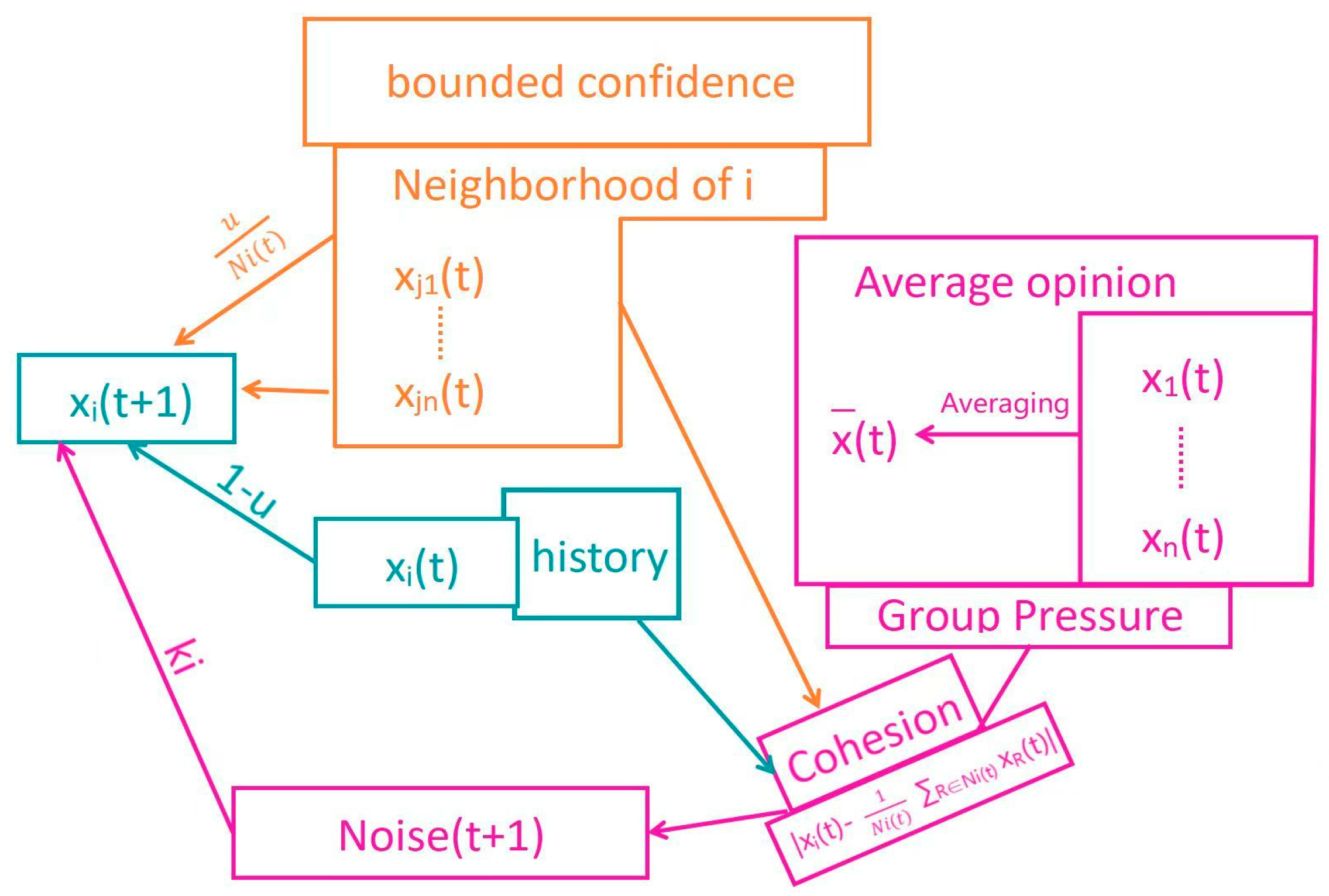



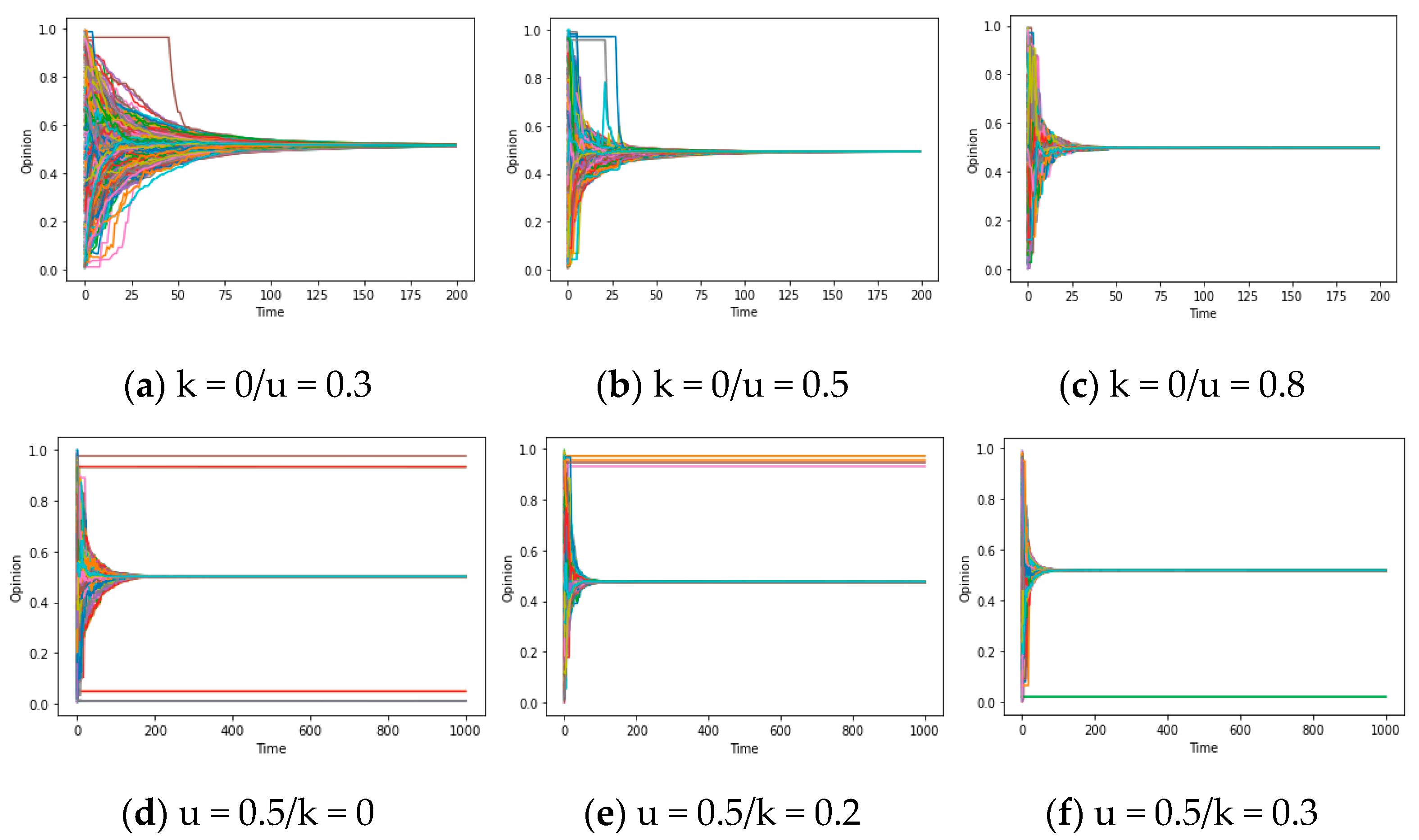
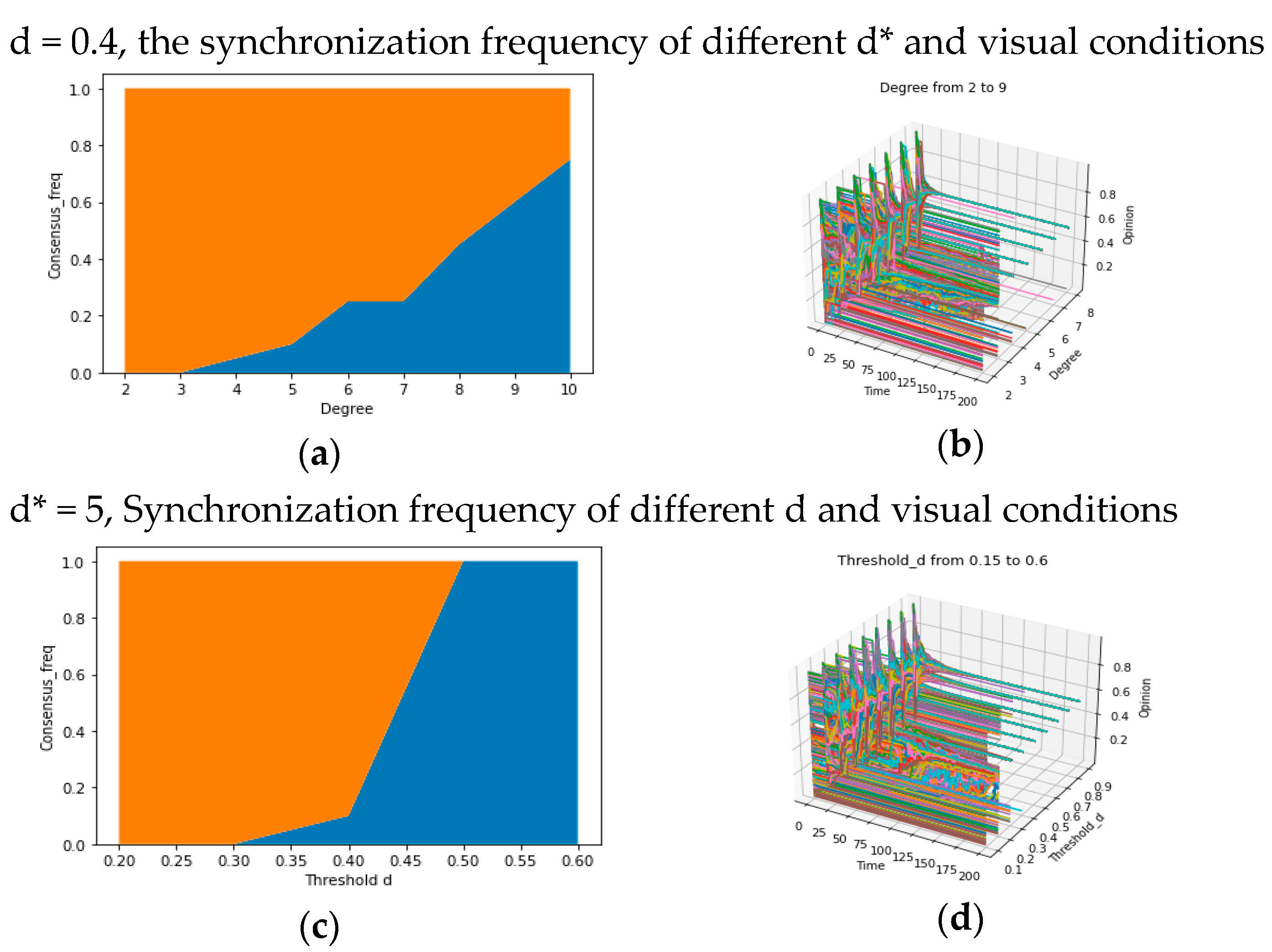
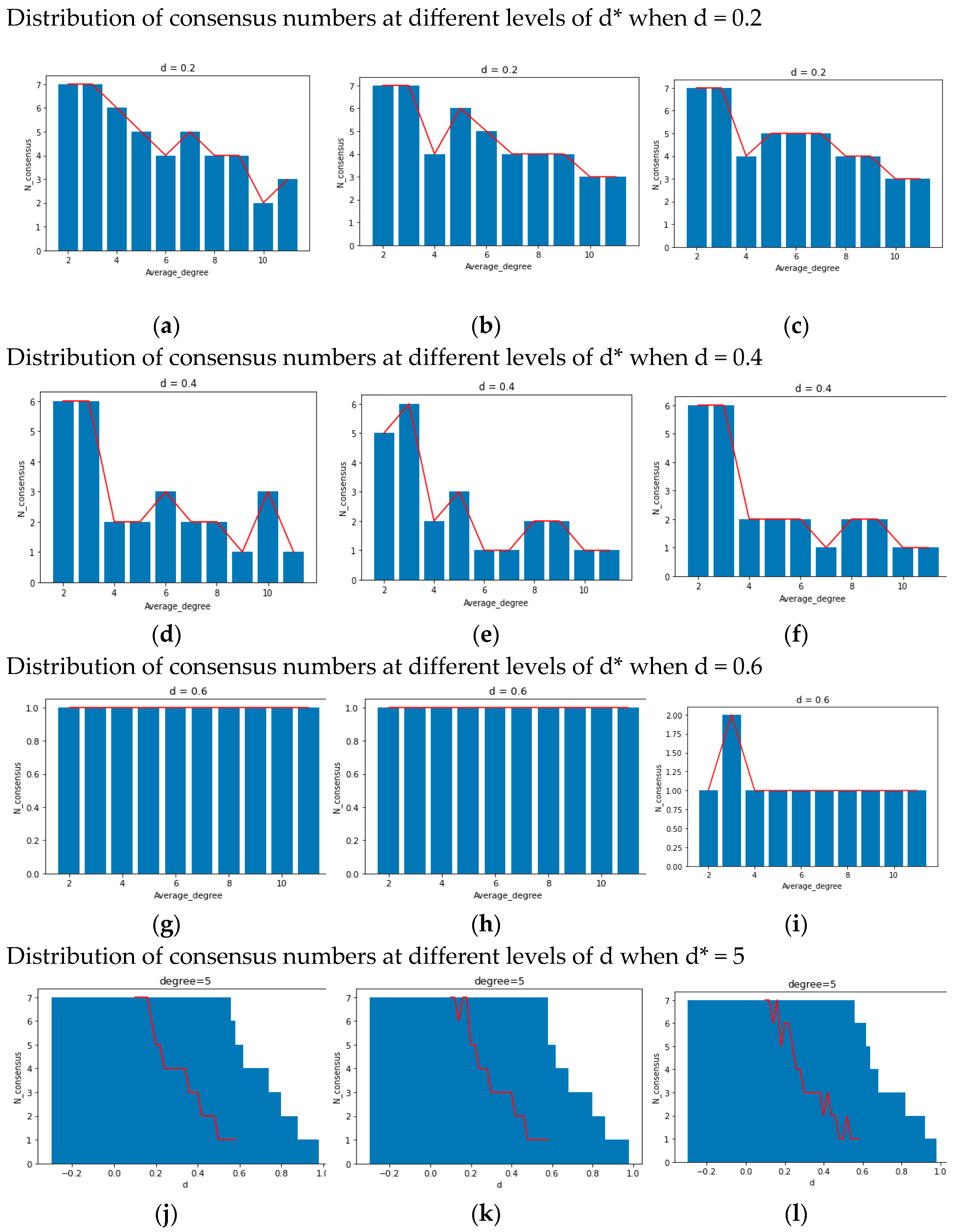



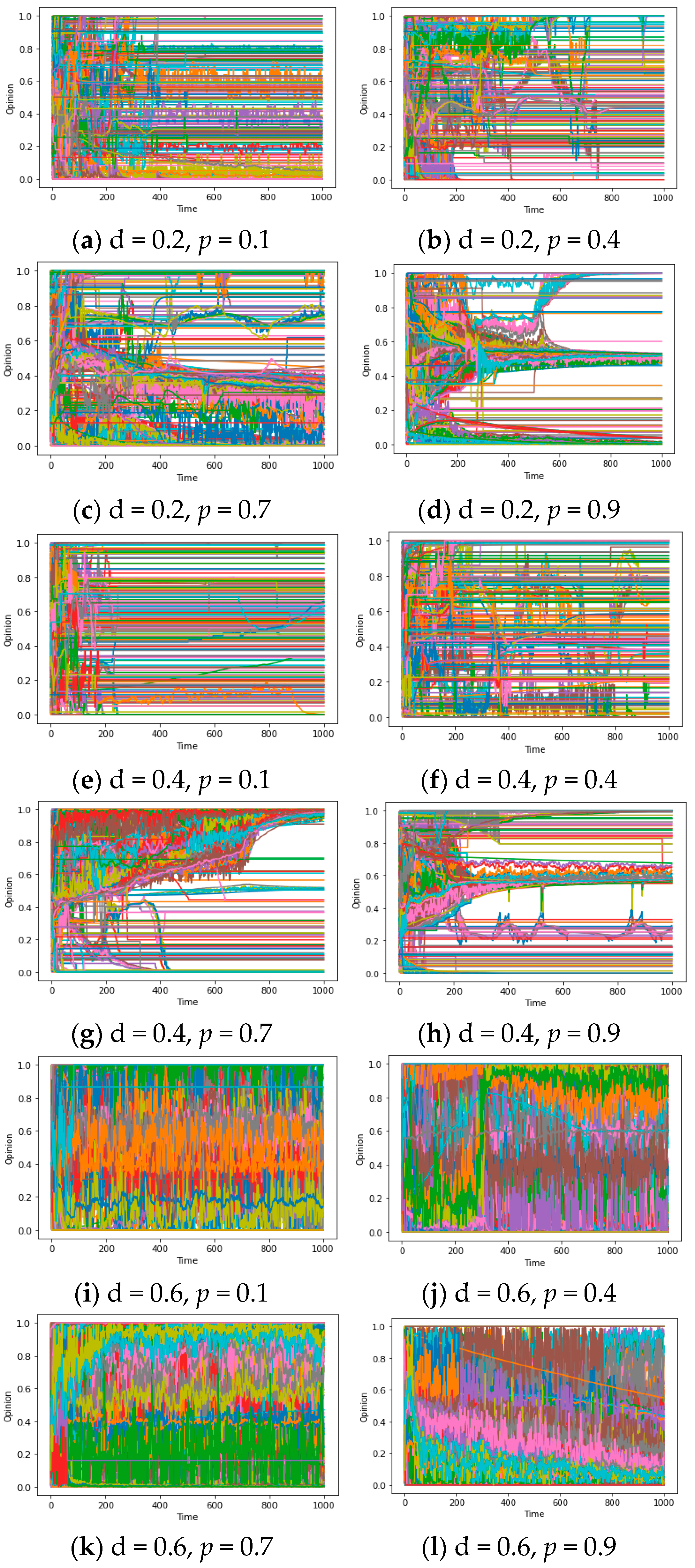
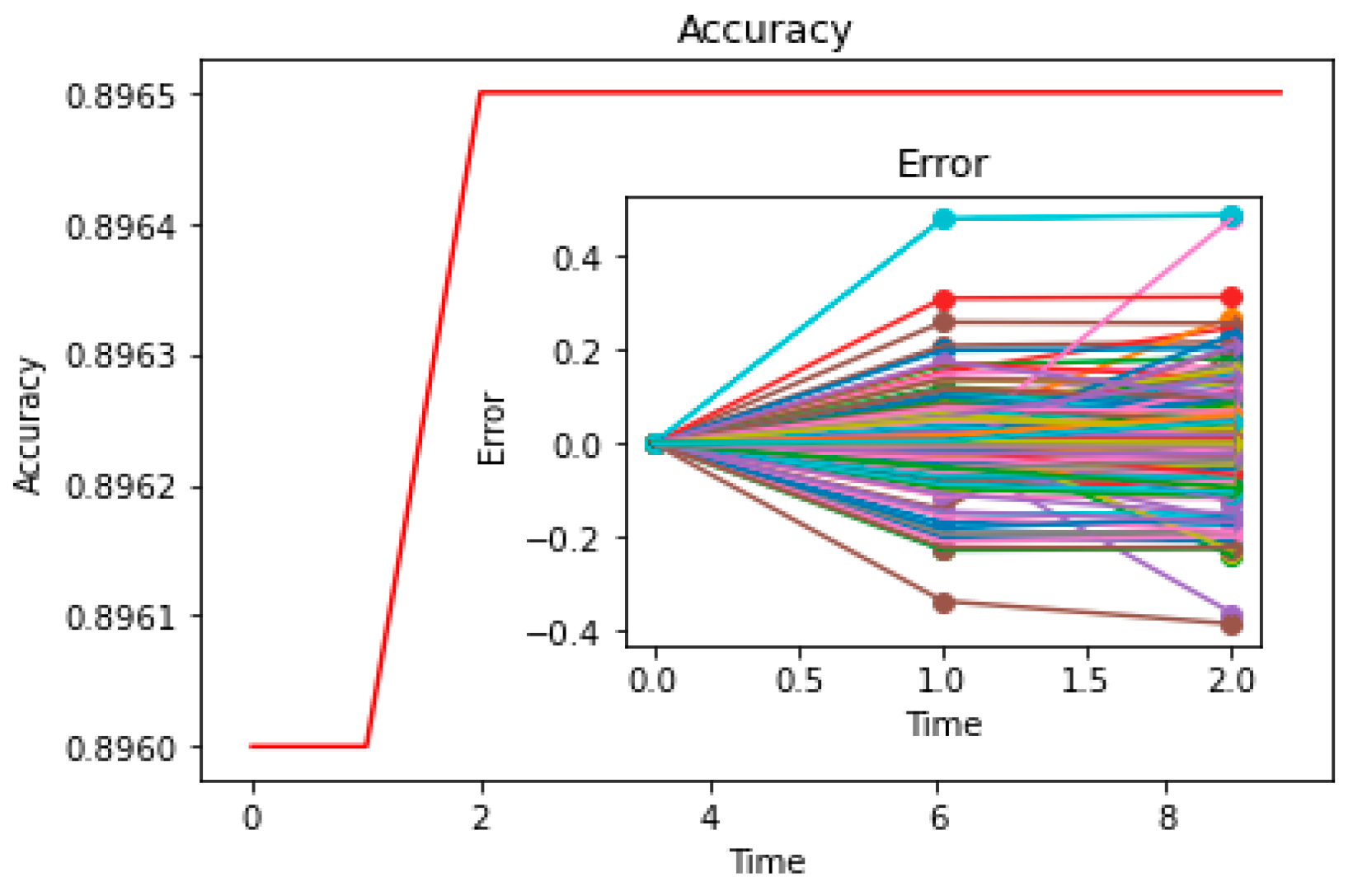

| Ideal Synchronization Theory | High Reachability (H) | Cocoon House Effect (C) | Low Reachability (L) |
|---|---|---|---|
| Assimilation (A) | Global consensus | High: <—/— | Local consensus |
| Low: <—/— | |||
| Exclusion (E) | Chaos | ------------------------- | Other phenomena |
| u/Bayesian Factor (0.1–0.5) | d/Bayesian Factor (0.1–0.5) | k/Bayesian Factor (0–0.1) |
|---|---|---|
| 0.2114; 6.72 | 0.178; 8.31 | 0.102; 5.44 |
| ui mean | di mean | ki mean |
| 0.094 | 0.102 | 0.037 |
| Values of Statistics for the Same Distribution Test | F(w) Distribution |
|---|---|
| T1(w) distribution | p value: 0.46 |
| T2(w) distribution | p value: 0.37 |
Disclaimer/Publisher’s Note: The statements, opinions and data contained in all publications are solely those of the individual author(s) and contributor(s) and not of MDPI and/or the editor(s). MDPI and/or the editor(s) disclaim responsibility for any injury to people or property resulting from any ideas, methods, instructions or products referred to in the content. |
© 2023 by the authors. Licensee MDPI, Basel, Switzerland. This article is an open access article distributed under the terms and conditions of the Creative Commons Attribution (CC BY) license (https://creativecommons.org/licenses/by/4.0/).
Share and Cite
Ding, F.; Li, Y.; Ding, K. Bounded Confidence and Cohesion-Moderated Pressure: A General Model for the Large-Scale Dynamics of Ordered Opinion. Entropy 2023, 25, 1219. https://doi.org/10.3390/e25081219
Ding F, Li Y, Ding K. Bounded Confidence and Cohesion-Moderated Pressure: A General Model for the Large-Scale Dynamics of Ordered Opinion. Entropy. 2023; 25(8):1219. https://doi.org/10.3390/e25081219
Chicago/Turabian StyleDing, Fangyikuang, Yang Li, and Kejian Ding. 2023. "Bounded Confidence and Cohesion-Moderated Pressure: A General Model for the Large-Scale Dynamics of Ordered Opinion" Entropy 25, no. 8: 1219. https://doi.org/10.3390/e25081219
APA StyleDing, F., Li, Y., & Ding, K. (2023). Bounded Confidence and Cohesion-Moderated Pressure: A General Model for the Large-Scale Dynamics of Ordered Opinion. Entropy, 25(8), 1219. https://doi.org/10.3390/e25081219






